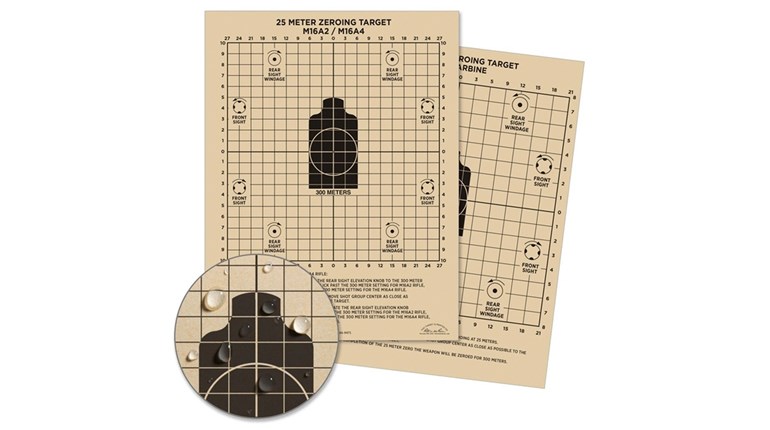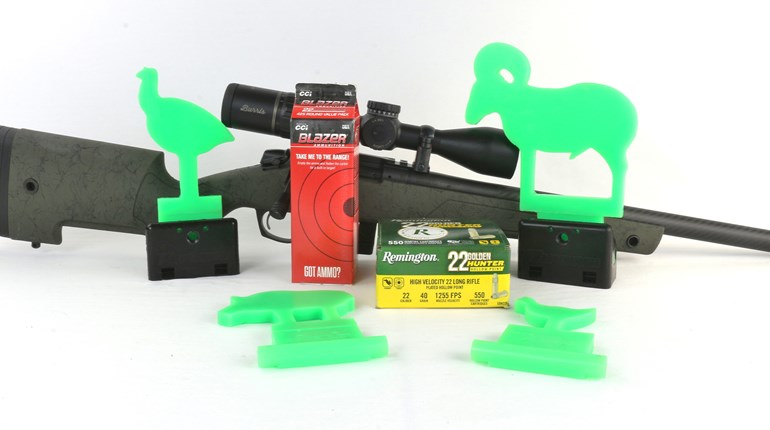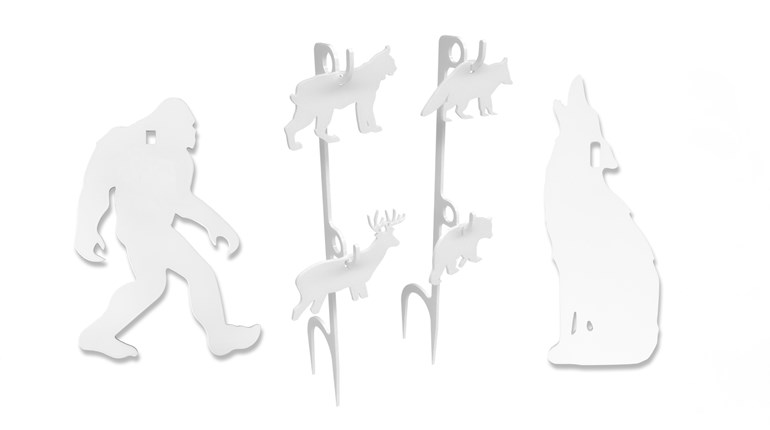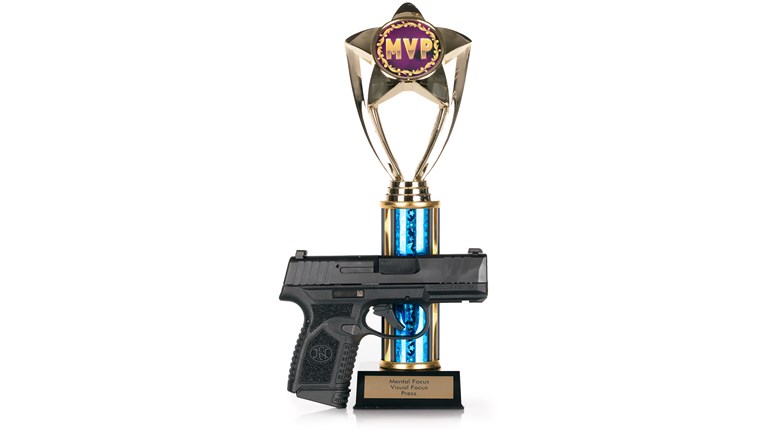
We confess we get our knickers in a bit of a twist when we see what some shooting brethren and sistren choose as targets. Some choices are conveniences edging up on necessity—in other words, “all we had.” Been there, done that, sympathy granted. Economics sometimes play a part too: Our somewhat more miserly range-mates often say, “I’m not paying XX cents for a stupid piece of paper!” This has its own penalties built right in, and is an argument essentially impossible to win—saving a few pennies trumps all for some folks. But this remains America after all—land of the free, home of the brave, and safe haven for those who can pinch pennies til they scream.
Other target choices can actually be dangerous, and before long we’ll talk about these too. Much of the time, our concerns here relate to materials and backstops: Just because something can be shot at or against doesn’t mean it should be, so it’s a safety issue. Most of these relate to training outdoors—a smallish concern for many urban gunnies, or else already well managed by range staff.
If you surmise we’re launching into a paper target mini-screed, congratulations—you win. (No, there are no prizes.) But our point remains unaltered: Target selection can have a big impact on advancing your skills, so it pays to spare some thought on the whys and wherefores in choosing.
We divide paper targets very roughly into four types. Here are what we see as their strengths and weaknesses.
Bull’s Eyes
These aren’t our favorites, but that doesn’t mean they’re bad, or even that we don’t use them. A truly huge series exist for a wide variety of disciplines, and the best are NRA-licensed: This means they comport with an “official” set of carefully considered dimension and materials standards. Bull’s eyes aren’t exactly plastered around on “real” targets.
Bull’s eye targets have one big advantage: Everybody understands how they work. The closer your shot or shots are to the center (the bull’s eye), the higher the score. Where the dimensions of the bull and the size of the successively lower scoring rings get their proportions is less apparent, and why you won’t help yourself much by practicing on these at distances other than what their labels suggest.

These dimensions are balanced against several other parameters, but the most crucial is easier to see than to describe. If you’ve ever looked over a venerable set of BoMar or Elliason sights on a 1911 at an NRA B-16 at precisely 25 yards, you’ll get it. There is obvious synergy between the dimensions of the sights and the target scoring circles. The dimensions of each work together to produce a repeatable sight picture, and help explain why shooters in both pistol and rifle disciplines produce amazingly precise groups with such apparently über conventional gear. Supplement this unvarying sight picture with their (generally fabulous) trigger skills, and it’s no wonder the resulting groups are so impressive. Do not confuse this match-up with such disciplines suddenly becoming “easy” either: These guys (and women) are good. For cultivating the ability to get a precise and repeatable sight/target view, these targets are “the bomb.”
The downside of these for just any old practice is two-fold. First is the simple converse of the distance/sight relationships: Shoot on these too close (or too far), and the dimensionally optimized math now works against you. Your target is either too generous or too minute, and the repeatability of sight picture that makes them work goes out the window. (There’s no trick here, just read the target. The distance(s) for which they are intended are printed right on the target of the licensed variety.)
The second is even more obvious. Bull’s eyes aren’t exactly plastered around on “real” targets. This deficiency alone should encourage you to broaden your practice regimen no matter how much you like—or how well you shoot on—bull’s eye targets.
Colored Targets
These are available in positively crazy variety, and in every format from NRA/Bull’s Eye knock-offs and blood-crazed zombies through minute dots and squares of mind-numbing variation.What we do know for sure is that defensive uses will likely be against visually-difficult or complex targets, not “shoot here!” orange or lime green.
We apologize in advance if these are your favorite targets, but generally speaking we aren’t huge fans. We concede our objection is a tad single-threaded, and reminiscent of a bull’s eye objection: We just don’t know what sort of actual target, sporting or otherwise, these simulate.
If you reply “who cares,” well, that’s emphatically your choice. But consider: With bright colors (often on bleached-white backgrounds), you’re prepping your mind and eye with a target presentation without field analogues. We grant it’s a hard proposition to adequately test, though nearly everyone has a pal who is great on clays, but weak in the blind or corn stubble, for instance. It’s hard to know how much those eye-drawing but unrealistic colors change the success/failure equation. What we do know for sure is that defensive uses will likely be against visually-difficult or complex targets, not “shoot here!” orange or lime green.

These targets still have their place, however garish. First is indoors: Even modern facilities often present challenging light conditions. Add a murky target to poorly illuminated sights, and solid training—to say nothing of actual precision—gets tougher.
A fortunate middle ground is available: Use a bright-colored or very high-contrast target to get your basics down—sight picture and the Three Ps. Just recognize the unwise limits of using these to the exclusion of other more realistic targets.
New shooters are another group who enjoy these disproportionately, so we don’t want to buzz-kill these welcome additions to the brother- or sisterhood. A variation on these are the now ubiquitous Birchwood Casey Shoot-N-C targets that use multiple layers to apparently “flare” around each new hit. They’re fun if a little pricey, and can be very useful training tools. If, however, they foster the habit of encouraging the eyes to leap off the front sight to see that flare between shots, they’re doing much more harm than any potential good.
Photorealistic Targets
Whether these are a subset or sequitur of the above is a little hard to say, and in practical terms it may not matter. Their main difference is obvious: Rather than geometric or humanoid shapes of varying imaginativeness in monochrome or color, they use photographs, mostly of bad guys ‘n gals, as a target. Everybody gets that their primary purpose is to train for defensive shooting situations. To what degree they accomplish this end is a great deal more subjective.Confidence (and competence) are one thing, arrogance (and disaster) quite another.
One of the “pluses” we like best is that they can force more “IFF”: identification, friend or foe, as we’ve discussed previously here. They do this through the simple expedient of coming in both armed and unarmed versions. This helps to seat in the mind the fact that every presentation of your defensive firearm does not necessarily result in a shot or shots. We heartily subscribe to the notion that you shouldn’t draw to threaten an assailant, but rather when you see no other option. In turn, however, it’s simply impractical to suggest that each assessment can be perfect. There will be situations when a drawn firearm cannot be morally (to say nothing of legally) employed, and your training must include some processing of this eventuality. Being fast and wrong is much worse than slightly slower, but correct.

Photorealistic targets also commonly simulate hostage situations, though we advise extreme caution here: Don’t get casual in your head about just how dangerous such a shot would be no matter how many times your hands and eyes repeat it. Confidence (and competence) are one thing, arrogance (and disaster) quite another.
As to color versus black-and-white, we’re not sure we see as big a difference as you might think. Color seems to encourage the “aim small, miss small” mindset slightly more because of the better visual differentiation color makes possible, and there’s reason to think this a problem. Real-world circumstances may not afford such differentiation due to a host of factors (movement, available light/shadows, color of clothing, etc.). Once again, you don’t want to train the eye and brain to depend on a sort of visual cue that may not be present. Black and white photorealistic targets seem to do this less.
Here, we get to what we think is a major (though unrecognized) “duh” in the color versus black-and-white conversation. Sight picture remains the core skill no matter what the shot, and by shooting on both, we keep from getting too locked in either on what we simply prefer, or on which we perform better. You want to learn to track those sights against any background, and nowhere does this matter more than in defensive shooting.
A down side for these targets? There are just sooooooo many. Selecting the subset(s) that works the best is expensive and daunting. Some people also consider these deeply impolitic—even racist—and consider it proof that you must be a latent murderer. About this last point, there is almost nothing to be done: Emoters emote, and reason—to say nothing of evidence—are a deep second and third in their mental process.
Silhouette Targets The many paper versions are often associated with the formalized shooting of qualification for military and law enforcement.
If you make us pick, these are our favorites. Sometimes they are combinations of nearly all of the foregoing types (more often paper), and other times they’re just buff cardboard. Be that as it may, perhaps it’s the physical durability we like best—less repairing/replacing equals more shooting, after all. The fact that we can “arm” them, orient them, paint them and use them indoors and outdoors lend to their considerable appeal.

The many paper versions are often associated with the formalized shooting of “qualification” for military and law enforcement (a whole bunch of them here), and this tells us a lot about what this group of relative gun professionals think. What makes this of interest and value to the non-MIL/LE shooter is that performance standards for agencies can be compared to our own shooting.
Downsides for silhouettes are much the same as they are for photorealistic targets, at least in the minds of anti-Second Amendment folks. To them, clearly you just can’t wait to harm your fellow man, and are actually practicing to do so. The fact that 100 million gun owners don’t do this with their 320 million firearms day in and day out is conveniently, perpetually overlooked. In most cases, there’s nothing you can do about this petulant, adolescent refusal to see how your improving preparation and skills protect everybody. Be unfailingly polite to such fools, but don’t let them waste your time or vote, either.


































